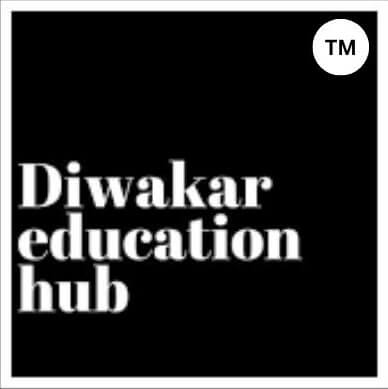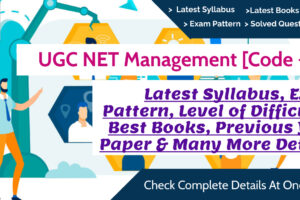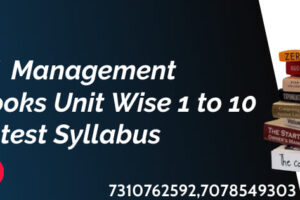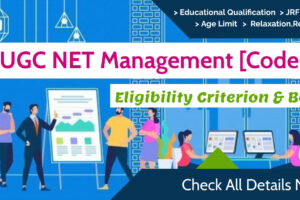UGC NET Management [Code-17] Latest Syllabus 2025 in English & Hindi [Download PDF]
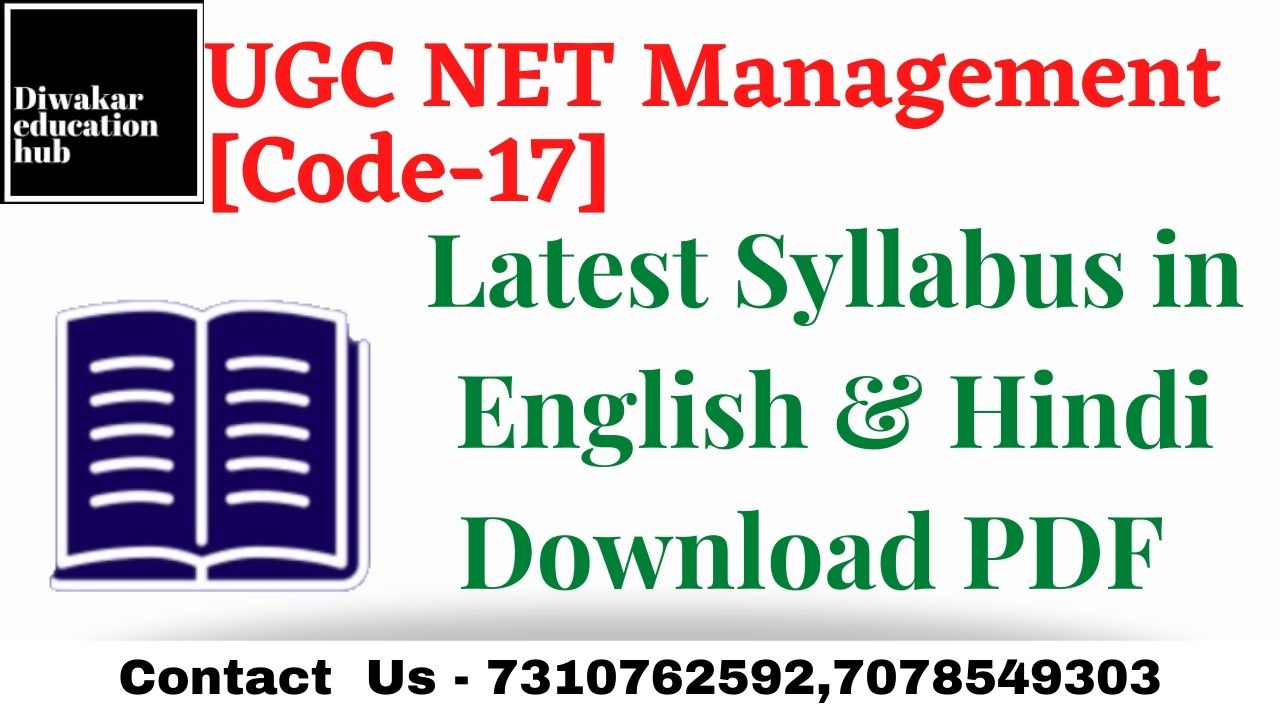
UGC NET Management [Latest Syllabus 2024] is one of the Vast & Interesting subjects of the UGC NET Exam. The Syllabus of Management is quite Lengthy You will have to cover Each Unit thoroughly. Topics Like – Management – Concept, Process, Organisational Behaviour, Emotions and Stress Management, Strategic Role of Human Resource Management, Green HRM, Leverages, Capital Budgeting, Strategic Management, and Statistics for Management. Many More. Every Year 80000+ Aspirants Apply for Management subjects & Hardly 5 % Qualified for UGC NET Management NET/JRF, But you Don’t worry
Table of Contents
UGC NET Management Syllabus Overview-
| Event | Answer |
|---|---|
| Exam Name | UGC NET Management |
| Number of Paper | Management + Paper-1 |
| Number of Units in Management Syllabus | 10 Units |
| Number of Topics in Management Syllabus | Each Unit Approx 50 |
| UGC NET Management Syllabus Medium | English & Hindi |
| UGC NET Management Syllabus Last Time Change | 2019 |
| UGC NET Management Paper Duration | 180 Minute |
List of Units UGC NET Management Syllabus-
The syllabus for NTA UGC NET Syllabus 2024 for Management comprises ten major units with various topics and subtopics as mentioned in this article. Candidates will need to go through all these ten units to make sure they have a fighting chance are clearing the examination. The 10 units under the management syllabus are as follows:
- Management
- Organizational Behaviour
- Human Resource Management
- Financial Statements
- Financial Management
- Strategic Management
- Consumer and Industrial Buying Behavior
- Statistics for Management
- International Business
- Entrepreneurship Development
Download Syllabus In PDF Click Here – Click Here
UGC NET Management Latest Syllabus Subject Wise-
UGC NET Management [Code-17] Syllabus Subject Based on Topics Such as Management – Concept, Process, Organisational Behaviour, Emotions and Stress Management, Strategic Role of Human Resource Management, Green HRM, International Business & more This means that you’d have to cover a lot of ground to get a surface-level understanding of the fundamentals. While the syllabus is dense, it would help to break down each component that makes a lesson. This is why we’ve broken them down into the Management UGC NET syllabus according to the names of the units themselves. It would be easier to digest what topics under them are involved so that it would be easy for you to be prepared for the upcoming exams.
The subject code for UGC NET Management Code – 17. It comprises two online papers namely Paper-I & Paper-II with Multiple Choice Questions (MCQ)s.
- UGC NET Management Paper 1 Syllabus tests teaching and reasoning ability, research aptitude, comprehension, divergent thinking, and general awareness.
- UGC NET Management Paper 2 Syllabus is based on Management. It tests your depth of knowledge and expertise in the respective subject.
| Unit | Topics for Paper 2 |
| Unit 1 | Management, Functions, Communication, Decision Making, Organisation Structure and Design, Managerial Economics, Demand analysis, Market Structures, National Income, Inflation, Business Ethics & CSR, Ethical Issues & Dilemma, Corporate Governance, Value-Based Organisation |
| Unit 2 | Organisational Behaviour, Individual Behaviour, Group Behaviour, Interpersonal Behaviour & Transactional Analysis, Organizational Culture & Climate, Work Force Diversity & Cross Culture Organisational Behaviour, Emotions and Stress Management, Organisational Justice and Whistle Blowing, Human Resource Management |
| Unit 3 | Strategic Role of Human Resource Management, Competency Mapping & Balanced Scoreboard, Career Planning and Development, Performance Management and Appraisal, Organization Development, Change & OD Interventions, Talent Management & Skill Development, Employee Engagement & Work-Life Balance, Industrial Relations, Trade Union & Collective Bargaining, International Human Resource Management, Green HRM |
| Unit 4 | Accounting Principles and Standards, Preparation of Financial Statements, Financial Statement Analysis, Preparation of Cost Sheet, Marginal Costing, Cost Volume Profit Analysis, Standard Costing & Variance Analysis, Financial Management, Concept & Functions, Capital Structure, Budgeting and Budgetary Control, Types and Process, Zero Base Budgeting, Leverages |
| Unit 5 | Value & Returns, Capital Budgeting, Dividend, Mergers and Acquisition, Negotiations, Leveraged Buyouts, Takeover, Portfolio Management, Derivatives, Working Capital Management, International Financial Management, Foreign Exchange Market |
| Unit 6 | Strategic Management, Strategic Analysis, Internal Analysis, Strategy Formulation, Retrenchment, Integration and Diversification, Business Portfolio Analysis, Strategy Implementation, Marketing, Market Segmentation, Positioning and Targeting, Product and Pricing Decision, Development, Pricing, Place and Promotion Decision |
| Unit 7 | Consumer and Industrial Buying Behaviour, Brand Management, Service Marketing, Customer Relationship Marketing, Retail Marketing, Emerging Trends in Marketing, International Marketing |
| Unit 8 | Statistics for Management, Dispersion, Probability Distribution, Sampling, Hypothesis Testing, Operations Management, Facility Location and Layout, Enterprise Resource Planning, Scheduling, Management, Operation Research |
| Unit 9 | International Business, Foreign Direct Investment, Role of International Financial Institutions, Information Technology, Artificial Intelligence, Big Data, Data Warehousing, Data Mining, and Knowledge Management |
| Unit 10 | Entrepreneurship Development, Intrapreneurship, Innovations in Business, Business Plan and Feasibility Analysis, Sickness in Small Industries, Institutional Finance to Small Industries |
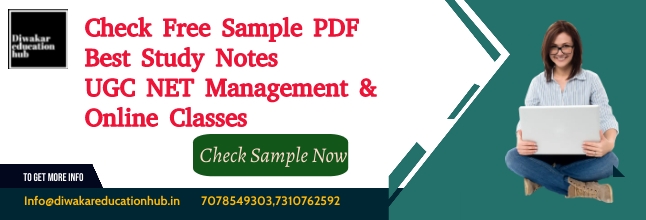
UGC NET Paper -1 Latest Syllabus 2025
The main objective is to assess the teaching and research capabilities of the
candidates. The test aims at assessing teaching and research aptitude as well.
Candidates are expected to possess and exhibit cognitive abilities, which include
comprehension, analysis, evaluation, understanding of the structure of arguments,
and deductive and inductive reasoning. The candidates are also expected to have a general awareness of teaching and learning processes in the higher education system. Further, they should be aware of the interaction between people, the environment, natural resources and their impact on the quality of life
Unit-I Teaching Aptitude
Teaching Aptitude is One of the Important Unit of Paper-1 Based on Topics such as teaching methods, teaching Concepts, Cognitive Development of students, Pedology, learner Centric Teaching Methods, Factors affecting teaching, Teaching Support Systems & More, if we Consider the Importance of This Unit then its a lot, Every year 4 to 6 Questions Asked from Teaching aptitude give you Upto 10 Marks Weightage which is very important for Getting Required Score. The level of Questions As Per Past Years is – Medium to Hard
| Topic Name | Topics in Details | Expected Questions Asked in Exam |
|---|---|---|
| Teaching | Concept, Objectives, Levels of teaching (Memory, Understanding and Reflective), Characteristics and basic requirements. | 1 Question |
| Learner’s characteristics | Characteristics of adolescent and adult learners (Academic, Social, Emotional and Cognitive), Individual differences. | 1 Question [ Cognitive Development Important one] |
| Factors affecting teaching related to | Teacher, Learner, Support material, Instructional facilities, Learning environment, and Institution | 2 Questions – [Teaching Aids] |
| Methods of teaching in Institutions of higher learning | Teacher-centred vs. Learner-centered methods; Off-line vs. Online methods (Swayam, Swayamprabha, MOOCs, etc.) | 2 Questions [ Swayam, MOOCs, Teacher Centric] |
| Teaching Support System | Traditional, Modern, and ICT-based. | 1 Question |
| Evaluation Systems | Elements and Types of evaluation, Evaluation in Choice Based Credit System in Higher education, Computer-based testing, Innovations in evaluation systems. | 1 or 2 Question [Choice Based testing, Evaluation System] |
Unit-II Research Aptitude
Research Aptitude is One of the Important & Analytical units of Paper-1 Based on Topics such as Research Types, Research Methods, Research Fundamental, Sampling, Standard error, Steps in Research, Hypothesis & More, if we Consider the Importance of This Unit then its a lot, not even in Paper -1 But Also in Paper -2 in each subject, you may find a Unit based on Research Every year 4 to 6 Questions Asked from Research aptitude give you Upto 10 Marks Weightage which is very important for Getting Required Score. The level of Questions As Per Past Years is – Medium to Hard [ Many Questions Asked Above Average]
| Topic Name | Topics in Details | Expected Questions Asked in Exam |
|---|---|---|
| Research | Meaning, Types, and Characteristics, Positivism and Post positivistic approach to research | 2 Question [Important – Types of Research Like- Applied Research, Experimental Research, Snowfall Research, etc |
| Methods of Research | Experimental, Descriptive, Historical, Qualitative, and Quantitative methods. | 2 Question [ All Research Methods] |
| Steps of Research | Step 1: Identify and develop your topic. Step 2: Do a preliminary search for information. … Step 3: Locate materials. … Step 4: Evaluate your sources. … Step 5: Make notes. … Step 6: Write your paper. … Step 7: Cite your sources properly. … Step 8: Proofread. | 2 Questions – [Most Expected Always] |
| Application of ICT in research | References and Bibliography Compilation. Article and Thesis / Dissertation | 1 Questions [ Expected ] |
| Research ethics. | Honesty: Honestly report data, results, methods and procedures, and publication status. Objectivity: Integrity: Carefulness: Openness: Respect for Intellectual Property: Confidentiality: Responsible Publication: | 1 Question [Expected] |
Unit-III Comprehension
This unit Include Reading Comprehension based on any case study or current affairs topics. As per Exam Pattern, every year 5 Questions are Asked from Passage & they its Fixed every year. The level of passage has always been medium to hard . the Starting 3 Questions is always been easy but in last 2 questions Might be difficult as compared to the First 3 Questions. if you practice 30 + Passage then it would be enough for Preparation, its if you weightage of 10 Marks
| Topic Name | Topics in Details | Expected Questions Asked in Exam |
|---|---|---|
| A passage of text be given. Questions be asked from the passage to be answered. | Passage based on case study & Current affairs Topics | 5 Questions |
Unit-IV Communication
Communication is one of the other theoretical & Analytical units of Paper-1 Based on Topics such as Communication: Meaning, types, and characteristics of communication, Communication Channel, Communication Barrier & More, if we Consider the Importance of This Unit then it now been Quite, In Past serval, the year’s the level of questions is Increase drastically. Now the questions asked from the depth of the topics Every year 4 to 6 Questions Asked from Communication give you up Upto 10 Marks Weightage which is very important for Getting Required Score. The level of Questions As Per Past Years is – Medium to Hard [ Mostly Question Asked in assertion & Reason]
| Topic Name | Topics in Details | Expected Questions Asked in Exam |
|---|---|---|
| Communication | Meaning, types, and characteristics of communication. | 2 Question [Important – The seven C’s are: clarity, correctness, conciseness, courtesy, concreteness, consideration, and completeness |
| Effective communication | Verbal and Non-verbal, Inter-Cultural, and group communications, Classroom communication. | 2 Question [ Based on Verbal & Non-Verbal Communication Mostly] |
| Barriers to effective communication | Physical Barriers. Perceptual Barriers. Emotional Barriers. Cultural Barriers. Language Barriers. Gender Barriers. Interpersonal Barriers. Removing Communication Barriers. | 2 Questions – [Most Expected Always] |
| Mass-Media and Society | mass media are newspapers, magazines, radio, advertisements, social media, television, the internet, and films/movies | 1 Questions [ Expected ] |
Unit-V Mathematical Reasoning and Aptitude
Mathematical Reasoning and Aptitude is One of the Important & Analytical units of Paper-1 Based on Topics such as reasoning types, Number Series, Arithmetic Math, Frequently Asked Questions on Ratio & Proportion, Profit & Loss, Percentage, Time & Distance & More if we Consider Importance of This Unit then its a lot, you need to practice Quite to score well in this Unit Every year 4 to 6 Questions Asked from Unit -5 give you Upto 10 Marks Weightage which is very important for Getting Required Score. The level of Questions As Per Past Years is – Medium to Hard [ Many Questions Asked Above Average]
| Topic Name | Topics in Details | Expected Questions Asked in Exam |
|---|---|---|
| Types of reasoning. | Deductive reasoning. Deductive reasoning is a type of reasoning that uses formal logic and observations to prove a theory or hypothesis. Inductive reasoning. Analogical reasoning. Abductive reasoning. Cause-and-effect reasoning. Critical thinking. Decompositional reasoning. | 1 Question |
| Series | Number series, Letter series, Codes, and Relationships | 2 Question [ Frequently Asked in exam] |
| Mathematical Aptitude | Fraction, Time & Distance, Ratio, Proportion and Percentage, Profit and Loss, Interest and Discounting, Averages etc | 2 Questions – [Most Expected Always] |
| Download Free Study Notes For UGC NET Paper-1 &2 [Trusted By Thousands of Students ] |
| Free Study Kit UGC NET Paper-1 Download |
| UGC NET Previous Year Question Paper All Subjects |
| UGC NET Study Notes [All Subjects ] |
| Join Free Online Classes UGC NET Paper-1 |
| Complete Study Plan UGC NET |
| UGC NET Latest Syllabus [All Subjects ] |
| UGC NET 200 + Free Online Test Series Paper-1 |
Unit-VI Logical Reasoning
Logical Reasoning is one of the Important & Lengthy Units of Paper-1 Include Conceptual Topics Such as Analogies, Venn Diagram, Pramanas, Indian Logic, Anumana & More, if we Consider Importance of This Unit then Very Much High, you need to practice Quite to score well in this Unit Every year 4 to 6 Questions Asked from Unit -6 give you Upto 10 Marks Weightage which is very important for Getting Required Score. The level of Questions As Per Past Years is – Medium to Hard [ Many Questions Asked Above Average] [Suggestion – Understand topics is very Important like the categorical statement of the form, Indian Logic, Mood and Figure, etc]
| Topic Name | Topics in Details | Expected Questions Asked in Exam |
|---|---|---|
| Understanding the structure of arguments | argument forms, the structure of categorical propositions, Mood and Figure, Formal and Informal fallacies, Uses of language, Connotations, and denotations of terms, Classical square of opposition. | 2 Question Important Topics [Mood & Figure & Square of Opposition, structure of categorical propositions |
| Evaluating and distinguishing | deductive and inductive reasoning. generalization, statistical generalization, anecdotal generalization, prediction, inference of past events | 1 Question [ Most Expected] |
| Analogies | Letter/Word Based Analogy. In this type of analogy reasoning, a pair of letters or words are given in a certain similarity between them. Number Based/Numerical Analogy. Letter and Number Based Analogy (Mixed Analogy) Image-Based Analogy. General Knowledge-Based Analogy. | 1 Questions – [Expected] |
| Venn diagram | Simple and multiple uses for establishing the validity of arguments. | 2 Questions [ Expected] |
| Indian Logic | Means of knowledge. | Nyaya school of Hindu philosophy 1 questions Expected |
| Evaluation Systems | Pramanas: Pratyaksha (Perception), Anumana (Inference), Upasana (Comparison), Shabda (Verbal testimony), Arthapatti (Implication), and Anupalabddhi (Non-apprehension). | [1 or 2 Question ] |
Unit-VII Data Interpretation
This Unit Asked 5 Questions based on Tabular DI, Pie Charts, Bar Graph, Line Graph, Ceselet DI, and Miscellaneous which give you 10 Marks if you do with 100 % Accuracy. Very Important to solve DI is that your Basic of Math Should be Clear your Calculation Speed should be fast so that you reduce the time to solve questions – [ Medium of Question – Moderate to Hard]
| Topic Name | Topics in Details | Expected Questions Asked in Exam |
|---|---|---|
| Sources, acquisition and classification of Data | Univariate data Bivariate data Multivariate data | Not Expected any Question |
| Quantitative and Qualitative Data | Quantitative data are data about numeric variables (e.g. how many; how much; or how often). Qualitative data are measures of ‘types’ and may be represented by a name, symbol, or number code. Qualitative data are data about categorical variables | 1 Question Expected |
| Graphical representation | (Bar-chart, Histograms, Pie-chart, Table-chart and Line-chart) and mapping of Data. | 1 DI Expected on Always with 5 Question |
| Data Interpretation. | Data Interpretation can be classified into a few categories such as Tabular DI, Pie Charts, Bar Graph, Line Graph, Ceselet DI, and Miscellaneous. | 1 DI |
| Data and Governance | A data governance model is a framework that outlines processes and systems for data creation, data storage and maintenance, and data disposal | Not Expected |
Unit-VIII Information and Communication Technology (ICT)
ICT is one of the Important Unit of Paper-1 Based on Topics such as General abbreviations and terminology, ICT and Governance, Use of the Internet, How Communication Technology work & More if we Consider the Importance of This Unit then its a lot, In-Unit emphasize basic Knowledge about ICT Like Why is Important, How its Work, Every year 4 to 6 Questions Asked from ICT give you Upto 10 Marks Weightage which is very important for Getting Required Score. The level of Questions As Per Past Years is – Medium to Hard [Most Important Topics are Memory Size, Abbreviation & More]
| Topic Name | Topics in Details | Expected Questions Asked in Exam |
|---|---|---|
| ICT | General abbreviations and terminology. Like- BASIC Beginner’s All-purpose Symbolic Instruction Code BCD Binary Coded Decimal BDPS Business Data Processing Systems | 1 Question Expected Always |
| Basics of Internet | Intranet, E-mail, Audio and Video-conferencing. | 2 Question [Expected] |
| Digital initiatives in higher education | Like – #1 Study Webs of Active Learning for Young Aspiring Minds(SWAYAM) learning made easy with SWAYAM. #2 SWAYAM Prabha: the 32 Educational DTH Channels. #3 National Digital Library (NDL) #4 National Academic Depository. #5 e-Shodh Sindhu. #6 Virtual Labs. #7 e-Yantra. #8 Campus Connectivity. | 2 Questions – [Most Expected Always] |
| ICT and Governance. | Topics Like Governance G2G: Government to Government G2C: Government to Citizen G2B: Government to Business G2E: Government to Employee | 1 Questions [ Expected ] |
Unit-IX People, Development, and Environment
People, Development, and Environment is One of the Important & Conceptual Units of Paper-1 Based on Topics such as Anthropogenic activities, pollutants, Environmental Protection Act, Paris Agreements, Flora & Fauna, Water Pollution, Climate Change & More, if we Consider the Importance of This Unit then its a lot, this Unit Emphasize knowledge about ecology & Environment test your Awareness about Climate change, etc.Every year 4 to 6 Questions Asked from Research aptitude give you up Upto 10 Marks Weightage which is very important for Getting the Required Score. The level of Questions As Per Past Years is – Medium to Hard [ Many Questions Asked Above Average]
| Topic Name | Topics in Details | Expected Questions Asked in Exam |
|---|---|---|
| Development and environment | Millennium development and Sustainable development goals. | Very Much Important Expected one 1 Question Always |
| Human and environmental interaction | Human and environment interaction: Anthropogenic activities and their impacts on the environment. | 1 Question [ Most Expected] |
| Environmental issues | Local, Regional, and Global; Air pollution, Water pollution, Soil pollution, Noise pollution, Waste (solid, liquid, biomedical, hazardous, electronic), Climate change and its Socio-Economic and Political dimensions. | 1 Questions – [Expected] Important Topic – Climate Change |
| Impacts of pollutants on human health | Topic Need to Learn – psychological complications, autism, retinopathy, fetal growth, and low birth weight. | 1 Questions [ Expected] |
| Natural and energy resources: | Solar, Wind, Soil, Hydro, Geothermal, Biomass, Nuclear, and Forests. | 1 Question Expected [ Important Topic Biomass & Geothermal ] |
| Natural hazards and disasters: Mitigation strategies | Topic Need to Learn- geological hazards, hydrological hazards, meteorological hazards, and biological hazards | [1 Question Expected] |
| Climate Protection Laws & Agreements | Environmental Protection Act (1986), National Action Plan on Climate Change, International agreements/efforts Montreal Protocol, Rio Summit, Convention on Biodiversity, Kyoto Protocol, Paris Agreement, International Solar Alliance. | 1 Question Expected [Important – Paris Agreement, Rio Summit] |
Unit-X Higher Education System
Higher Education is one of the Important Units of Paper-1 Based on Topics such as Oriental, Conventional and Non-conventional learning programs in India, Professional, Technical and Skill-Based education, Policies, Governance, and Administration. & More, if we Consider the Importance of This Unit then it’s a lot, Every year 4 to 5 Questions Asked from Higher Education give you up Upto 10 Marks Weightage which is very important for Getting the Required Score. The level of Questions As Per Past Years is – Medium to Hard
| Topic Name | Topics in Details | Expected Questions Asked in Exam |
|---|---|---|
| Institutions of higher learning and education in ancient India | Education in the Sutras and Epics Education in Buddhist Era Main Educational Centers and Universities in Ancient India TAKSHASHILA OR TAXILA Nalanda Vikramshila Mithila Odantapuri | 2 Question Expected Always |
| Evolution of higher learning and research in Post Independence India | Sarkar Committee (1945) University Education Commission (UEC) UGC became a statutory organization by the act of parliament in 1956. The Nehruvian Period (1947-1964 National Policy on Education (NPE) in 1968, Planning Commission (established in 1950 by Nehru) Five-Year Plan | 2 Question [Expected] |
| Oriental, Conventional, and Non-conventional learning programs in India. | Oriental learning Programmes, Adyar Library Asiatic Society ancient wisdom | 1 Questions – [Most Expected Always] |
| Professional, Technical, and Skill-Based education. | School Education & LiteracyPrimary Schooling Secondary education Senior Secondary Education Higher Education (Tertiary Education)Academic Degrees (Non-professional) Professional Degrees Technical Degrees Vocational Education (Skilled Based) | 1 Questions [ Expected ] |
| Value education and environmental education. | At the elementary school level, environmental education can take the form of science enrichment curriculum, natural history field trips, community service projects, and participation in outdoor science schools. | 1 Question |
| Policies, Governance, and Administration. | Parts of Constitution Territory of the Union Fundamental Rights Right to equality (Articles 14-18) Right to freedom (Articles 19-22) Right against exploitation (Articles 23-24) Type of Writs Fundamental Duties The President The Union Council of Ministers The Union Legislature The Indian Judicial System | 1 Question Expected Always |
NOTE: (i) Five questions each carrying 2 marks are to be set from each
Module.
(ii) Whenever graphical/pictorial question(s) are set for sighted
candidates, a passage followed by an equal number of questions and
weightage be set for visually impaired candidates.
UGC NET Management Latest Syllabus in Hindi 2024
यूजीसी नेट प्रबंधन [कोड -17] पाठ्यक्रम विषय प्रबंधन जैसे विषयों पर आधारित है – अवधारणा, प्रक्रिया, संगठनात्मक व्यवहार, भावनाएं और तनाव प्रबंधन, मानव संसाधन प्रबंधन की रणनीतिक भूमिका, हरित एचआरएम, अंतर्राष्ट्रीय व्यापार और अधिक इसका मतलब है कि आपके पास होगा बुनियादी बातों की सतह-स्तरीय समझ प्राप्त करने के लिए बहुत सारी जमीन को कवर करना। जबकि पाठ्यक्रम सघन है, यह पाठ बनाने वाले प्रत्येक घटक को तोड़ने में मदद करेगा। यही कारण है कि हमने उन्हें इकाइयों के नाम के अनुसार प्रबंधन यूजीसी नेट पाठ्यक्रम में तोड़ दिया है। यह समझना आसान होगा कि उनके अंतर्गत कौन से विषय शामिल हैं ताकि आपके लिए आगामी परीक्षाओं के लिए तैयार होना आसान हो जाए।
| यूनिट- I: व्यवसाय प्रबंधन |
| प्रबंधन: अवधारणा, प्रक्रिया, सिद्धांत और दृष्टिकोण, प्रबंधन भूमिकाएं और कौशल कार्य: योजना, आयोजन, स्टाफिंग, समन्वय और नियंत्रण। संचार: प्रकार, प्रक्रिया और बाधाएं। निर्णय लेना: अवधारणा, प्रक्रिया, तकनीक और उपकरण संगठन संरचना और डिजाइन: केंद्रीकरण, विकेंद्रीकरण, और नियंत्रण की अवधि, प्रकार, प्राधिकरण, उत्तरदायित्व प्रबंधकीय अर्थशास्त्र: अवधारणा और महत्व मांग विश्लेषण उपयोगिता विश्लेषण, उदासीनता वक्र, लोच और पूर्वानुमान बाजार संरचनाएं: बाजार वर्गीकरण और मूल्य निर्धारण राष्ट्रीय आय: अवधारणा, प्रकार और मापन मुद्रास्फीति: अवधारणा, प्रकार और मापन, व्यावसायिक नैतिकता और सीएसआर, नैतिक मुद्दे और दुविधा, कॉर्पोरेट प्रशासन, मूल्य-आधारित संगठन |
| यूनिट- II: संगठनात्मक व्यवहार |
| संगठनात्मक व्यवहार: इसका महत्व और सिद्धांत व्यक्तिगत व्यवहार: व्यक्तित्व, दृष्टिकोण, धारणा, मूल्य, सीखना और प्रेरणा समूह व्यवहार: टीम निर्माण, नेतृत्व, पारस्परिक व्यवहार और लेनदेन विश्लेषण, समूह गतिशीलता, संगठनात्मक संस्कृति और जलवायु, कार्यबल विविधता और क्रॉस संस्कृति संगठनात्मक व्यवहार, संगठनात्मक न्याय और सीटी बजाना, भावनाएं और तनाव प्रबंधन मानव संसाधन प्रबंधन: अवधारणा, परिप्रेक्ष्य, प्रभाव और हाल के रुझान, मानव संसाधन योजना, भर्ती, और चयन, प्रेरण, प्रशिक्षण और विकास, नौकरी विश्लेषण, नौकरी मूल्यांकन, और मुआवजा प्रबंधन |
| यूनिट- III: एचआरएम |
| योग्यता मानचित्रण और संतुलित स्कोरबोर्ड कैरियर योजना और विकास मानव संसाधन प्रबंधन की रणनीतिक भूमिका प्रदर्शन प्रबंधन और मूल्यांकन प्रतिभा प्रबंधन और कौशल विकास कर्मचारी सगाई और कार्य-जीवन संतुलन संगठन विकास, परिवर्तन और ओडी हस्तक्षेप औद्योगिक संबंध: विवाद और शिकायत प्रबंधन, श्रम कल्याण और सामाजिक सुरक्षा ट्रेड यूनियन और सामूहिक सौदेबाजी अंतर्राष्ट्रीय मानव संसाधन प्रबंधन: अंतर्राष्ट्रीय, व्यापार, हरित एचआरएम की मानव संसाधन चुनौती |
| यूनिट- IV: वित्तीय प्रबंधन और लेखा |
| लेखांकन सिद्धांत और मानक, वित्तीय विवरण तैयार करना वित्तीय विवरण विश्लेषण, अनुपात विश्लेषण, फंड फ्लो और कैश फ्लो विश्लेषण, ड्यूपॉन्ट विश्लेषण, लागत पत्रक तैयार करना, सीमांत लागत, लागत मात्रा लाभ विश्लेषण, मानक लागत और भिन्नता विश्लेषण, वित्तीय प्रबंधन, अवधारणा और कार्य पूंजी संरचना : सिद्धांत, पूंजी की लागत, स्रोत और वित्त; बजट और बजटीय नियंत्रण, प्रकार और प्रक्रिया, शून्य आधार बजट लाभ: परिचालन, वित्तीय और संयुक्त उत्तोलन, EBIT-EPS, विश्लेषण, वित्तीय ब्रेकईवन बिंदु और उदासीनता स्तर। |
| यूनिट-वी: बिजनेस फाइनेंस |
| मूल्य और रिटर्न: पैसे के लिए समय वरीयता, बांड और शेयरों का मूल्यांकन, जोखिम और रिटर्न; पूंजी बजट: निवेश की प्रकृति, मूल्यांकन, तरीकों की तुलना; जोखिम और अनिश्चितता विश्लेषण लाभांश: सिद्धांत और निर्धारण विलय और अधिग्रहण: कॉर्पोरेट पुनर्गठन, मूल्य निर्माण, विलय बातचीत, लीवरेज बायआउट, टेकओवर पोर्टफोलियो प्रबंधन: सीएपीएम, एपीटीडीरिवेटिव्स: विकल्प, विकल्प मूल्य निर्धारण, भुगतान, विकल्प वायदा अनुबंध और भविष्य अनुबंध कार्यशील पूंजी प्रबंधन: निर्धारक, नकद, सूची, प्राप्य और भुगतान योग्य प्रबंधन, फैक्टरिंग अंतर्राष्ट्रीय वित्तीय प्रबंधन, विदेशी मुद्रा बाजार |
| यूनिट-VI: सामरिक प्रबंधन |
| सामरिक प्रबंधन: इसकी अवधारणा, प्रक्रिया, निर्णय और प्रकार सामरिक विश्लेषण: बाहरी विश्लेषण, कीट, उद्योग विश्लेषण के लिए पोर्टर का दृष्टिकोण, आंतरिक विश्लेषण: संसाधन-आधारित दृष्टिकोण, मूल्य श्रृंखला विश्लेषण रणनीति तैयार करना: एसडब्ल्यूओटी विश्लेषण, कॉर्पोरेट रणनीति – विकास, स्थिरता, छंटनी, एकीकरण और विविधीकरण, व्यापार पोर्टफोलियो विश्लेषण – बीसीजी, जीई बिजनेस मॉडल, एंसॉफ के उत्पाद-बाजार विकास मैट्रिक्स रणनीति कार्यान्वयन: परिवर्तन की चुनौतियां, विकासशील कार्यक्रम मैकिन्से 7 एस फ्रेमवर्क मार्केटिंग: अवधारणा, अभिविन्यास, रुझान और कार्य, ग्राहक मूल्य और संतुष्टि बाजार विभाजन, स्थिति और लक्ष्यीकरण उत्पाद और मूल्य निर्धारण निर्णय: उत्पाद मिक्स, उत्पाद जीवन चक्र, नया उत्पाद विकास, मूल्य निर्धारण: प्रकार और रणनीतियाँ स्थान और प्रचार निर्णय: मार्केटिंग चैनल और मूल्य नेटवर्क, VMS, IMC, विज्ञापन और बिक्री प्रचार |
| यूनिट-VII: उपभोक्ता और औद्योगिक खरीद व्यवहार |
| उपभोक्ता व्यवहार के सिद्धांत और मॉडल सेवा विपणन: सेवा गुणवत्ता और ब्रांड का प्रबंधन, सेवा फर्मों की विपणन रणनीतियाँ ग्राहक संबंध विपणन: संबंध निर्माण, रणनीतियाँ, मूल्य और प्रक्रिया ब्रांड प्रबंधन: ब्रांड की भूमिका, ब्रांड इक्विटी, इक्विटी मॉडल, विकासशील ब्रांडिंग रणनीति; ब्रांड नाम निर्णय, ब्रांड एक्सटेंशन, और वफादारी रसद और आपूर्ति श्रृंखला प्रबंधन, चालक, मूल्य निर्माण, आपूर्ति श्रृंखला डिजाइन, डिजाइनिंग और बिक्री बल का प्रबंधन, व्यक्तिगत बिक्री खुदरा विपणन: भारत में हालिया रुझान, खुदरा आउटलेट के प्रकार। विपणन में उभरते रुझान: अवधारणा ई-मार्केटिंग, डायरेक्ट मार्केटिंग, डिजिटल मार्केटिंग और ग्रीन मार्केटिंग की अंतर्राष्ट्रीय मार्केटिंग: एंट्री मोड डिसीजन, प्लानिंग मार्केटिंग मिक्स फॉर इंटरनेशनल मार्केट्स |
| यूनिट-VII: उपभोक्ता और औद्योगिक खरीद व्यवहार |
| प्रबंधन के लिए सांख्यिकी: अवधारणा, केंद्रीय प्रवृत्ति और फैलाव के उपाय, संभाव्यता वितरण: द्विपद, जहर, सामान्य और घातीय, डेटा संग्रह और प्रश्नावली डिजाइन नमूनाकरण: अवधारणा, प्रक्रिया, और तकनीक परिकल्पना परीक्षण: प्रक्रिया; टी, जेड, एफ, ची-स्क्वायर परीक्षण सहसंबंध और प्रतिगमन विश्लेषण संचालन प्रबंधन: भूमिका और दायरा संचालन अनुसंधान: परिवहन, कतार निर्णय सिद्धांत, पीईआरटी / सीपीएमएफ सुविधा स्थान और लेआउट: साइट चयन और विश्लेषण, लेआउट – डिजाइन और प्रक्रिया उद्यम संसाधन योजना: ईआरपी मॉड्यूल, ईआरपी कार्यान्वयन ; निर्धारण; लोड हो रहा है, अनुक्रमण, और निगरानी; गुणवत्ता प्रबंधन और सांख्यिकीय गुणवत्ता नियंत्रण, गुणवत्ता मंडल, कुल गुणवत्ता प्रबंधन: काइज़न, बेंचमार्किंग, सिक्स सिग्मा; आईएसओ 9000 श्रृंखला मानक |
| यूनिट-IX: अंतर्राष्ट्रीय व्यापार |
| अंतर्राष्ट्रीय व्यापार: वैश्वीकरण युग में व्यवसाय का प्रबंधन; अंतर्राष्ट्रीय व्यापार के सिद्धांत; भुगतान संतुलन प्रत्यक्ष विदेशी निवेश: लाभ और लागत; विश्व व्यापार संगठन के तहत व्यापार और निवेश का बहुपक्षीय विनियमन; अंतर्राष्ट्रीय व्यापार प्रक्रियाएं और दस्तावेज़ीकरण; EXIM नीतियां डेटा वेयरहाउसिंग, डेटा माइनिंग, और ज्ञान प्रबंधन: अवधारणाएं तकनीकी परिवर्तन अंतर्राष्ट्रीय वित्तीय संस्थानों की भूमिका: आईएमएफ और विश्व बैंक सूचना प्रौद्योगिकी: प्रबंधन अनुप्रयोगों में कंप्यूटर का उपयोग; एमआईएस, डीएसएस, आर्टिफिशियल इंटेलिजेंस और बिग डेटा |
| यूनिट-X: उद्यमिता विकास |
| उद्यमिता विकास: इसकी अवधारणा, प्रकार, सिद्धांत और प्रक्रिया, उद्यमिता दक्षताओं का विकास व्यवसाय में नवाचार: नवाचारों के प्रकार, निर्माण और पहचान, महिला उद्यमिता और ग्रामीण उद्यमिता इंट्राप्रेन्योरशिप: अवधारणा और प्रक्रिया, अवसर, व्यावसायिक विचारों की स्क्रीनिंग, व्यवसाय योजना और व्यवहार्यता विश्लेषण: अवधारणा और तकनीकी, बाजार और वित्तीय विश्लेषण की प्रक्रिया; भारत में सूक्ष्म और लघु उद्योग; लघु उद्योगों में एसएसआईएस बीमारी को बढ़ावा देने में सरकार की भूमिका: कारण और पुनर्वास लघु उद्योगों को संस्थागत वित्त: वित्तीय संस्थान, वाणिज्यिक बैंक, सहकारी बैंक, सूक्ष्म वित्त |
Benefits Of Analysis Latest UGC NET Management Syllabus 2024
Knowing the syllabus and exam pattern is essential for any preparation to be successful. You can definitely score more with the proper use of the UGC NET Management Syllabus.
Some notable benefits of the new UGC NET Management 2024 Syllabus are as below:
- UGC NET Management Syllabus covers all topics that are important for the examinations.
- UGC NET Syllabus for Management also mentions the weightage allotted to different units and chapters, knowing which you may form a strategy for preparing for chapters with high or low weightage.
- Question paper format is also explained in a syllabus.
- Having a clear understanding of your syllabus and the weightage of various sections will definitely help you decide how much time you should dedicate to each section.
- Generally, the exam papers for each course are designed as per the syllabus prescribed for that course.
- So, preparing according to the topic and instructions mentioned in the syllabus obviously helps to crack the exam with good scores.
Important topics UGC NET Management
- All Topics are Very Important But Some Topics are Very Much Important For Exam Like
- Business Ethics & CSR,
- Theories of International Trade
- Measures Of Central Tendency
- Designing and Managing Sales Force
- SWOT Analysis
- Zero base Budgeting Leverages: Operating, Financial and Combined Leverages ETC
UGC NET Management Cut-off 2021 Exam [ December & June Exam]
UGC NET Management is one of the Favorite subject of the students Among the UGC NET Exam Subjects, In Every Six Months Term Around 30000 to 35000 Students appeared for UGC NET Management. this time [December 2020 & June 2021] 22348 students appeared for UGC NET Management and As per the past year cutoff This time Gone quite Near you can check all the details below in Table.
| Code | Subject Name | Total Appeared | Qualified for NET | Qualified for NET & JRF | Percantage & Marks /Percentiale for NET | Percantage &Marks /Percentiale for JRF |
|---|---|---|---|---|---|---|
| 17 | Management | 22348 | 1345 | 219 | Gen 160 [53%] EWS-148 [49%] OBC -144 [48 %] SC – 138 [46 %] ST – 136 [45 %] | Gen-176 [58%] EWS -168 [56 %] OBC -164 [54 %] SC -158 [53 %] ST -152 [51 %] |
How to Crack the UGC NET Management Exam?
- Examine the most recent exam trend and syllabus.
- Prepare a systematic timetable
- You can make a list of UGC NET Important dates and activities so that you can review them at the last minute.
- Make use of best Management UGC NET Books or NTA NET Study Materials.
- Solve previous years’ UGC NET papers to learn the exact paper pattern, labeling weightage, and exam difficulty level.
- Check your answers with UGC NET Answer Keys and analyze your results after completing solving the papers.
- As far as possible, solve the NET Mock Test Paper. It will help to improve your exam pace and accuracy.
- For statistics and probability-type questions, you must work on improving techniques of approximation and interpretation.
- Cover Each & Every Topic thoroughly Do Weekly Revision of All Topics which you learned Last Week
| ownload Free Study Notes For UGC NET Paper-1 &2 [Trusted By Thousands of Students ] |
| Free Study Kit UGC NET Paper-1 Download |
| UGC NET Previous Year Question Paper All Subjects |
| UGC NET Study Notes [All Subjects ] |
| Join Free Online Classes UGC NET Paper-1 |
| Complete Study Plan UGC NET |
| UGC NET Latest Syllabus [All Subjects ] |
| UGC NET 200 + Free Online Test Series Paper-1 |
UGC NET Management 4-Month’s Preparation Plan 2025
This gives you 4 months to prepare for the examination. Now we are fully aware of the fact that a single time-table cannot suit everyone’s preference. So, being mindful of that, we have prepared you a standard plan which you can modify as per your Schedule and daily schedule.
| Preparation Time | 4 Months (16 Weeks) |
| Total Chapters/ Topics to Prepare | 10 |
| Total Sub-Topics | Over 80 + |
| Studying Hours Per Day | 4 – 5 Hours |
| Number of Days Required to Prepare Each Unit | 10 Days |
| Number of Chapters Completed in a Month | 2 Chapters |
| Break Days or Extra Days Each Month | 2 – 3 Days* |
| Time Taken to Complete Entire Syllabus | 3.5 Months |
| Remaining Time | 15 Days |
| Days to Solve Sample Papers/ Model Papers/ Mock Tests | 20 Days |
| Days Left for Final Revision | 15 Days |
Frequently Asked Question UGC NET Management Syllabus (FAQ)
Q1. What is the UGC NET Management syllabus 2025 ?
Ans- The Management syllabus for UGC NET has two papers. Paper 1 is a common paper for all the candidates. The Management syllabus for Paper 2 is divided into ten units there are Different 13 Subjects
Q2. How Many Units are in UGC NET Management Syllabus?
Ans- UGC NET Management Syllabus is divided into 10 Units. After Management 10 Units of Paper-1 Compulsory [Paper-1 & 2 – 20 Units]
Q3. How Many Topics are given in UGC NET Management Syllabus in Each Unit?
Ans – As per the Syllabus in Each Unit are More than 50 Topics & Many Subtopics . all topics are equally Important suggest going through all Topics.
Q4.How can we download the UGC NET Management Syllabus 2025 PDF?
Ans- the Download Management Syllabus Fill the Form given above & Click on Submit Button after submitting it will redirect you to Syllabus where you can Download & Also Save on Your Google Drive
Q5.Is there any change in UGC NET Management Syllabus recently?
Ans- No, Since 2019 June the Syllabus is the Same. No Change Made by UGC. Generally Syllabus changes after 5 to 7 Years
Q6. How to prepare UGC NET Management Syllabus 2025?
Ans- Check Details & Study Plan Above in Article
Q7.What is the Management Syllabus in Hindi of UGC NET 2025?
Ans- You Can Check Syllabus in Hindi Given in Article
Q8.How Many Questions Asked in Exam from Each Unit of UGC NET Management Syllabus?
Ans- From Each Unit of Paper-2 Management 8 to 10 Questions Asked in Exam from different topics. Total 100 Questions Asked in Exam from Management & 50 from Paper-1, These Questions may be in the form of Assertion Reason, Matching, Statement or Simple MCQ
| Syllabus of Other Subject UGC NET Paper-2 | Syllabus of Other Subject UGC NET Paper-2 |
|---|---|
| Commerce | Computer Science |
| Management | Forensic Science |
| HRM [COde -55] | Physical Education |
| History | Geography |
| English Literature | Yoga |
Tag:net management unit-i, UGC NET exam pattern, ugc net management books, UGC NET Management Latest Syllabus, UGC NET Management Latest Syllabus 2022, ugc net Management previous year paper, ugc net management study material, ugc net management syllabus 2024, ugc net management syllabus book, UGC NET Management Syllabus Download in pdf, UGC NET Management syllabus in hindi, ugc net management syllabus paper 1 pdf, Ugc net management syllabus pdf download, ugc net syllabus
